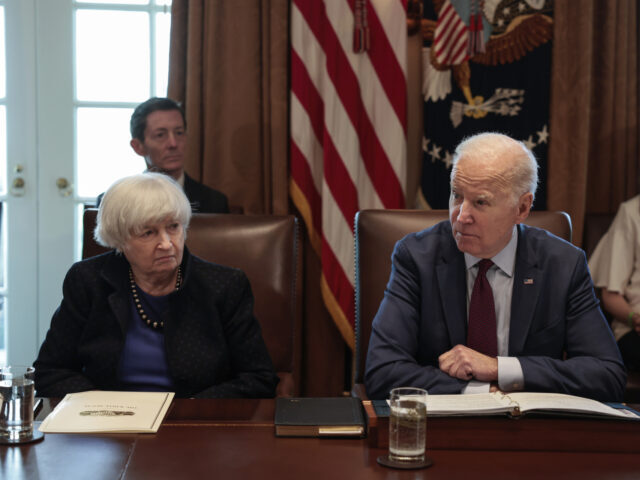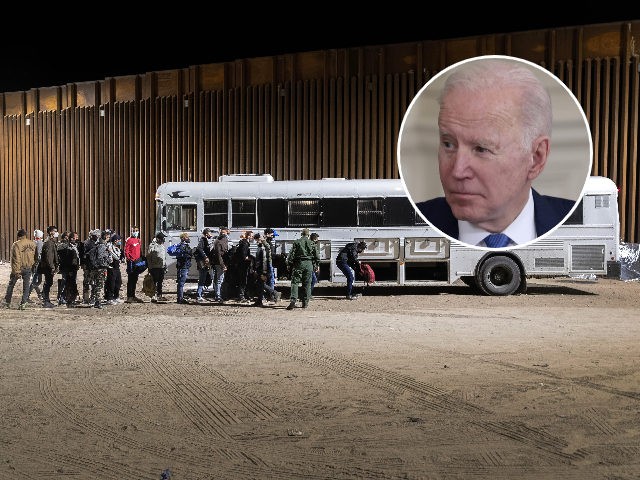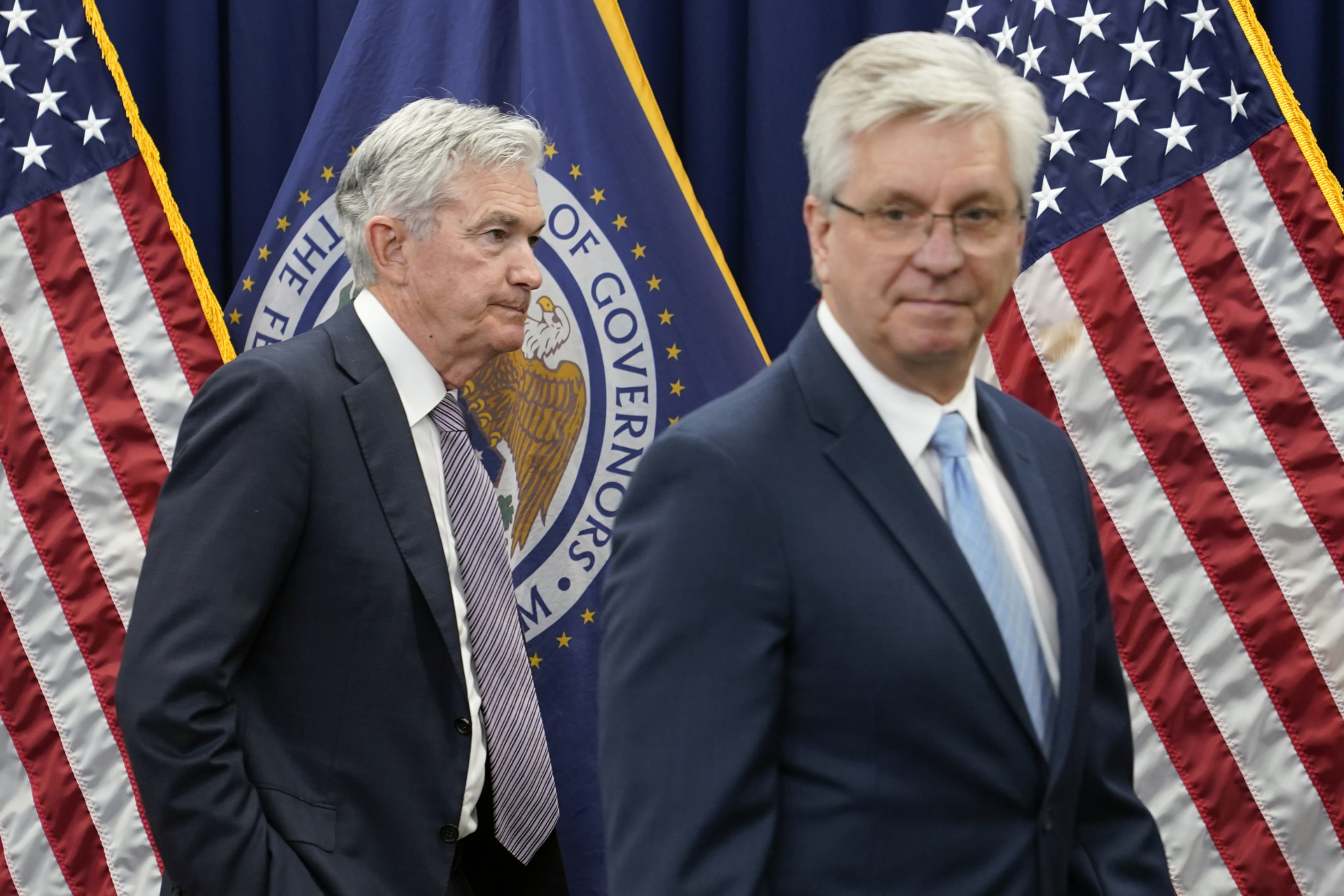KENNEDY ON THE BIDEN REGIME'S CENSORSHIP OF AMERICA THROUGH HIGH TECH.
Help Me Stop (JOE'S) Censorship
https://www.youtube.com/watch?v=5-swhVNhJFM&ab_channel=TeamKennedy
Bidenomics: U.S. Budget Deficit Explodes 23% Higher to $1.7 Trillion

The U.S. budget deficit increased 23 percent to $1.7 trillion, an increase of $320 billion, in the year after the Biden administration pushed through the Inflation Reduction Act which it claimed would close the government’s funding gap.
The explosive growth in the deficit came as revenue fell $457 billion from a year ago and expenses decreased by just $137 billion. Total spending for the year came in at $6.134 trillion.
Spending would have been higher if the Supreme Court had not declared Biden’s student loan forgiveness program illegal.
The deficit adds to the U.S. debt total, which the government said earlier this week had reached $33.6 trillion. That is more than $250,000 per household and more than $99,000 per person in the U.S. The Pete G. Peterson Foundation has calculated that if every household in the U.S. contributed $1,000 a month to debt reduction, it would take 21 years to pay down the debt.
Bidenflation Busted the Budget
Much of the increase in the deficit can be chalked up to the runaway inflation sparked by super-sized spending programs—including the Inflation Reduction Act’s $500 billion in new expenditures and tax breaks, the $1.9 trillion American Rescue Plan, and $1 trillion of infrastructure outlays—pushed for by Biden administration.
As a result of inflation, Social Security’s cost-of-living adjustments drove up the program’s cost of $134 billion, for example.
The Federal Reserve was forced to raise interest rates at a record pace and downsize its mammoth balance sheet in an effort to bring down inflation, raising the cost of government borrowing. Outlays for interest on the public debt increased $162 billion, going from $475 billion to $659 billion.
Interest expense as a percentage of GDP rose to 3.3 percent, the highest level since 2001. According to the Pete Peterson Foundation, the U.S. government is spending $2 billion a day on interest payments.
Higher interest rates also lowered the amount of revenue the government receives from the Federal Reserve, adding to the deficit.
The banking failures triggered by higher interest rates resulted in a $101 billion increase in Federal Deposit Insurance Corporation outlays.
On Friday, President Joe Biden asked Congress to authorize aid to Ukraine and Israel, requesting a massive $106 billion in spending the administration claims will go to bolster “national security.” Around $61 billion of that total is for additional spending on aid to Ukraine.
Government revenues in 2023 fell to 16.5 percent of gross domestic product.
The Buck Stops…With The Other Guys
The Biden administration quickly blamed its predecessor for the budget shortfall, attempting to deny responsibility for the fiscal situation of the government.
“This year, the effect of the Trump tax cuts on revenues and deficits is clear,” said a White House official.
The administration continues to claim the economy is doing extremely well despite polls showing widespread rejection of Biden’s leadership on the economy.
“The U.S. economy remains resilient despite global headwinds,” Treasury Secretary Janet Yellen said.
While the consensus among economists no longer calls for a recession in the near term, a recent Wall Street Journal poll showed that the economy is expected to grow slightly less than one percent next year. The Conference Board said this week that it still expects the economy to fall into a “shallow recession” next year.
where, oh where, did all the money go????
Joe Biden Demands Billions to Fly, Bus More Migrants into U.S. Communities

President Joe Biden’s deputies are asking Congress for $14 billion extra to help bus illegal migrants up to the U.S. border and onward into hotels in many cities and towns around the nation.
The request is being touted as “border security” even though very few funds would be used to exclude economic migrants. For example, Biden’s deputies have ushered more than 300,000 economic migrants through the U.S. border in September alone. The 2023 inflow has added up to roughly 2.5 million, not counting legal migrants and temporary workers.
Instead, much of the requested money would be used to help more job-seeking migrants reach the U.S. border, register and release them, and then bus them to hotels, job training, and American workplaces around the United States.
WATCH: Migrants Waiting for Entry to Roosevelt Hotel
emorrisThe massive request — buried in a larger $106 billion request — may be intended to cover planned migrant aid by Democrat-run cities through the 2024 presidential campaign. That cash flow would help pro-migration groups minimize voters’ recognition of the huge costs to cities, taxpayers, and Americans.
The government’s flood of illegal migrants is already displacing many lower-income Americans from decent jobs and housing as well as granting a huge windfall to employers, real estate investors, and government agencies.
The Washington Post reported:
The request includes more than $6 billion for “border operations,” including $4.4 billion for DHS [Department of Homeland Security], and $3.1 billion for additional border patrol agents, asylum officers, and processing personnel. The request also includes $1.4 billion for state and local governments to help them with shelter and services for migrants.
“Giving the Biden Admin more money to fuel its disastrous open-borders resettlement operation is insanity,” responded Sen. Bill Hagerty (R-TN). “It would worsen the border crisis, not stop it,” he tweeted.
The funding will “offer ZERO actual border security while providing more money to process more people … & continue to rack up mountains of debt,” said a tweet by Rep. Chip Roy (R-TX).
In August, Breitbart News reported on the details of the White House’s request for $4 billion in claimed “border security” funding:
Up to $800 million is intended to fund new migrant pathways from Colombia, Guatemala, Costa Rica, and Ecuador into U.S. communities. These “Safe Mobility Offices” are intended to offer a safer and cheaper route for African, European, and Asian economic migrants who are seeking to break into the United States.
A growing number of global migrants fly into Ecuador or Columbia before starting their trek to the Texas border. This growing flow of illegals skews the nation’s economy in favor of investors, Wall Street, and the coastal states.
The request also asks for an extra $714 million for Immigration and Customs Enforcement agency, which was created to deport illegal migrants. But the request also asks for permission to move funding around in the agency — so that funding can be used for the housing program that would shelter migrants while they take the U.S. jobs they need to pay off smuggling debts. The program would also provide illegal migrants with free legal advice on how to slip through the immigration rules that were enacted to protect Americans from illegal migrants.
The request also asks for an additional $600 million for the Federal Emergency Management Agency. That agency funds many of the transport networks and shelters that migrants use as they displace locals from jobs in New York, Chicago, and other cities.
Extraction Migration
The federal government has long operated an unpopular economic policy of Extraction Migration. This colonialism-like policy extracts vast amounts of human resources from needy countries, reduces beneficial trade, and uses the imported workers, renters, and consumers to grow Wall Street and the economy.
The migrant inflow has successfully forced down Americans’ wages and boosted rents and housing prices. It has also pushed many native-born Americans out of careers in a wide variety of business sectors and contributed to the rising death rate of poor Americans.
The lethal policy further sucks jobs and wealth from heartland states by subsidizing coastal investors with a flood of low-wage workers, high-occupancy renters, and government-aided consumers.
The population inflow also reduces the political clout of native-born Americans because the population replacement allows elites and the establishment to divorce themselves from the needs and interests of ordinary Americans.
Migration — especially labor migration — is unpopular among swing voters. In September, a Reuters/Ipsos poll of 4,415 adults showed that a 54 percent majority of Americans said immigration under President Joe Biden is making life harder for all Americans, up from 48 percent in July. Fifty-seven percent of independents agreed with the “harder” view, while just 17 percent of all adults “strongly” disagreed.
Breitbart Business Digest: Fed Officials Warn the Economy Will Slow or We’ll Face a Second Wave of Inflation

Waller Warns That Something’s Got to Give
The Federal Reserve is not buying the optimism about the economy that the White House has been marketing under the brand Bidenomics.
In speeches this week, Federal Reserve officials made it very clear that they plan to hold their benchmark interest rate target steady at the Federal Open Market Committee (FOMC) meeting the week after next. Fed Chairman Jerome Powell locked-in a pause when he defied predictions that he would strike a slightly more hawkish tone in his speech Thursday.
Going into the week, markets were pricing in less than a 20 percent chance of a hike. If Fed officials felt this view was mistaken, they had plenty of opportunities to correct it in one of the dozen or so speeches, talks, and interviews they gave this week. Just the fact that none appeared to attempt a correction is an indicator that the Fed—which has shown a distaste for surprising the market when it hikes—is in agreement on that point.
Fed officials sent a secondary message in their recent appearances that received less attention. The clearest form of this came in the title of Fed Governor Christopher Waller‘s talk in London: “Something’s Got To Give.”

Federal Reserve Board Chair Jerome Powell, left, with Christopher Waller on May 23, 2022, in Washington, DC. (AP Photo/Patrick Semansky)
Waller noted that inflation had come down toward the Fed’s target this year even while employment had stayed high and growth robust, a development he describes as “overwhelmingly positive” for both the Fed’s employment and price stability goals. He noted, however, that “things are looking a little too good to be true.”
“This is great news, and while I tend to be an optimist, things are looking a little too good to be true; so it makes me think that something’s gotta give. Either growth moderates, fostering conditions that support continued progress toward our two percent inflation objective, or growth doesn’t, possibly undermining that progress. But which is going to give—the real side of the economy or the nominal side?” Waller said.
In other words, either growth would have to slow down or inflation was likely to rise again.
Waller elaborated:
I find myself thinking about two possible scenarios for the economy in the coming months. In the first, the real side of the economy slows. This is the scenario broadly reflected in the September Summary of Economic Projections (SEP) by FOMC participants, where an easing in demand helps bring the economy into better balance with supply and allows inflation to move closer to our 2 percent objective. In this scenario, I believe we can hold the policy rate steady and let the economy evolve in the desired manner.
But I also can’t avoid thinking about the second scenario, where demand and economic activity continue at their recent pace, possibly putting persistent upward pressure on inflation and stalling or even reversing progress toward 2 percent. In such a scenario, failing to take action in a timely way carries the considerable risk of undermining what have been fairly stable inflation expectations and possibly unwinding the work that we have done to date. Thus, more action would be needed on the policy rate to ensure that inflation moves back to target and expectations remain anchored.
Waller next pointed out that real economic activity has accelerated in recent months, specifically pointing to the Blue Chip survey of business forecasters third-quarter real GDP forecast of 3.5 percent growth. He also mentioned the Atlanta Fed’s GDPNow model “coming in even higher,” although he declined to point out that it was coming in at 5.4 percent growth.
“We’ll get a first look at the third quarter GDP number next week, but it seems clear that economic activity was substantially higher for July through September than earlier in the year,” Waller said.
Slower Growth or More Inflation and Higher Rates
So, the question will be what happens in the fourth quarter of this year and the first quarter of next year. Will the acceleration of the economy be sustained, keeping unemployment low? Is the third-quarter’s growth evidence of persistently higher demand? If the answer to those questions is in the affirmative, according to Waller, inflation is likely to return.
“[I]f the third quarter data represents the beginning of persistently stronger demand, then we can expect that strength to show up in the fourth-quarter data, including by putting upward pressure on prices, which could have ramifications for upcoming decisions on monetary policy,” Waller said.
Although Waller did not explicitly say this, it would be wise for the Fed not to wait until it sees inflation actually rising before it begins raising rates again. The “wait till you see the whites of their eyes” strategy was one of the failures that got us runaway inflation in the first place. If Fed officials are convinced that persistently higher growth will reignite inflation, they should act to tamp down on the growth and not wait until the official inflation indexes rise.
The other possibility is that growth slows on its own, which would help keep inflation down, as Waller also noted in his speech:
Sometimes an uptick in activity is followed by some payback, or slowdown. For example, if firms pull construction forward because of good weather, then current structures investment will be high now but lower in the next period. Thus, we want to be careful and not pay too much attention to the specific month activity took place but instead average growth over a couple of quarters to get a clearer picture of the underlying strength of the economy.
To see this point more clearly, recall that at the start of this year, personal consumption expenditures increased dramatically in the first quarter but subsequently grew less rapidly in Q2 of 2023. A similar dynamic may be playing out now.
The slow growth payback is the scenario economists are forecasting right now. The most recent survey by Bloomberg shows economists expect the economy to grow at a 0.7 percent annualized rate in the fourth quarter, 0.4 percent in the first quarter of next year, and 0.6 percent in the second quarter. The forecasts in the Wall Street Journal‘s survey of top economists are similar: 0.9 percent in the fourth quarter, 0.4 percent in the first quarter, and 0.6 percent in the second quarter.
The bond market, however, seems to disagree. Rapidly rising bond yields over the past few weeks—the 10 year rose above five percent for a time on Friday—would suggest that investors expect growth to continue at a stronger pace and are pricing in more inflation.
“The bond market is starting to price in structurally higher inflation,” SMBC Nikko Securities Chief Economist Joe Lavorgna wrote in a client note on Friday. “Consequently, the Fed may have to raise rates more, and the slowdown in the economy may have to be deeper and longer than some project.”
This is not just the view of Waller, of course. In a slightly less explicit form, Powell said the same thing on Thursday.
“Still, the record suggests that a sustainable return to our 2 percent inflation goal is likely to require a period of below-trend growth and some further softening in labor market conditions,” Powell said.
In other words: to get inflation down, the economy will need to slow.
Bad News for Bidenomics
Either outcome is probably bad news from the perspective of those busily touting the achievements of Bidenomics. Either growth slows to a glacial pace in the crucial months leading up to the election, likely resulting in rising unemployment and renewed recession worries, or growth continues at a pace fast enough to force the Fed to raise rates to stave off a second wave of inflation.
Taking the longer view, the high growth into 2024 is probably the worst scenario for a Biden successor or Biden’s second term. As Lavorgna points out, the Fed’s reaction to higher growth will cause a tightening that may lead to a deeper and longer downturn in the economy. A slowdown into 2024, on the other hand, would probably indicate faster growth in 2025, the first year of the next presidency or Biden’s second term.
No comments:
Post a Comment